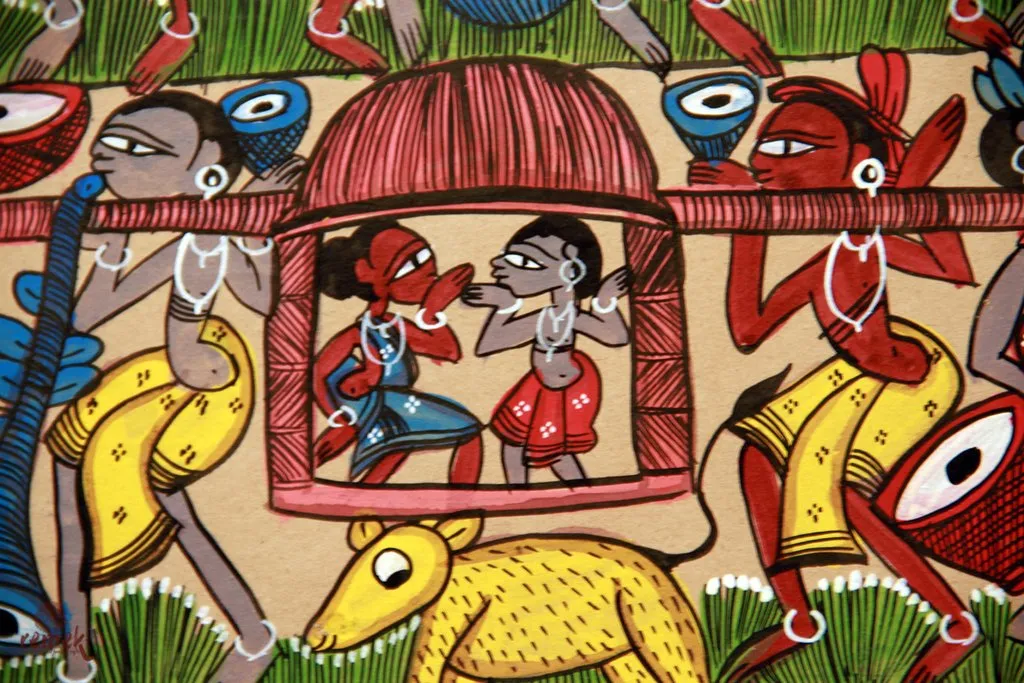
The Santal or Santhal, are a Munda ethnic group native to India and Bangladesh. Santals are the largest tribes in Jharkhand state of India in terms of population and are also found in the states of Assam, Tripura, Bihar, Chhattisgarh, Odisha and West Bengal.
Santal is most likely derived from a Bengali Exonym. The terms refer to inhabitants of Saont, now in the Midnapore region of west Bengal, the traditional homeland of the Santals. Their ethnonym is Hor Hopon (sons of mankind)
In the Santal religion, the majority of revence falls on a court of spirit (bonga), who handle different aspects of the world and who are placated with prayers and offerings.
There are seven kinds of marriage recognized in the Santal community, each with it’s own degree of social acceptance. The most elaborate kind of marriage is the ‘hapramko balpa’, or ancestor’s marriage, but the most widely practiced is ‘kesimek’. In this form of marriage, a boy and girl who wish to marry decide to go to the groom’s house and stay there a while. When the girl’s family are made aware of their situation, the ‘Jog Manjhi’ of the girl’s village arrives at the house of the couple’s intentions. The couple are summoned to the village headman and the bride is asked whether she wishes to set a date for ‘kesimek’. If she replies ‘no’, the boy’s family will have to pay a small fine to the ‘Jog Manjhi’ of the girl’s village, who would take the girl back to her father. If she assents, the boy’s family is consulted for the best day for the kesimek. The bride and groom are not bound by any obligation to marry. During this time, the ‘Jog Manjhi’ says in the village to give all the information he can to the bride’s father both in determining what would be a groom bride price to demand and whether the marriage night end in a short time.
On the day of the ‘Kesimek’ ceremony, a group of man from the bride’s village, including ‘Jog Manjhi’, headman, village elders and the bride’s father and some relatives arrives at the bride’s village. They are seated at the headman’s house with respect and organized by ‘Marang’ or ‘Hudin’ status. Meanwhile, the groom’s family gather to discuss the bride price the groom’s father should pay. The two parties then meet and the fathers negotiate the bride price to be paid. The groom is first asked whether he wishes to marriage to continue. As a symbolic marriage contract, the groom’s father gives a small amount of cash and gives ‘Handi’ (Rice beer) to the guests. The negotiations for bride price continue between the fathers exclusive until an amount is reached. Although this is nowadays in cash, livestock or other goods are not uncommon. The bride price is generally light and it is seen wrong to stop two young people from marrying because of a disagreement is reached, celebrations ensue and festive drinking continues into the night.
A short time afterwards, a relative of the groom along with the ‘Jog manjhi’ of the groom’s village handover the bride price to the bride’s family. Afterwards the couple arrive in the bride’s natal village. The bride greets her mother first and neighbors are invited to share ‘Handi’ reserved for ‘pera’ 9pera for handi0, while getting acquainted with the husband. When the couple laves the bride’s village, the bride pays her respect to the headman in his counteryard.
At the “Manjhi’ Than; the bride thanks the Headman for all he has done and gives a symbolic gift. The Headman then blesses the couple and wishes the bride strength, good luck and many strong sons. The couple then Leaves for groom’s village to start their new life.
Marriages done by ‘Kesimek’ involve very little ritual: Santal society has clearly defined roles for marriage, and the choice of the couple is respected. Decisions by families are done in a spirit of consensus rather than adversarially, and marriage is seen just as important for the entire village as for the couple.
